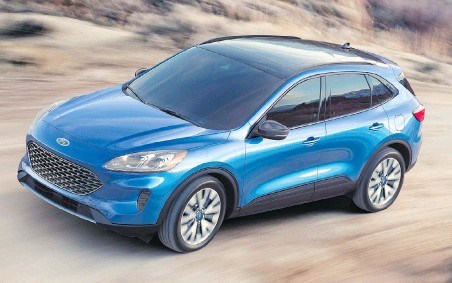Ford made a good model even better with the introduction of the revamped 2020 Escape, its compact SUV.
It might be a cliché, but the new compact SUV is longer, lower and wider than the model it replaces. That has allowed Ford designers to give the body more flowing lines and make it appear less boxy.
Although the vehicle height hasn’t changed, the vehicle’s new, lower beltline means that the greenhouse area is more expansive. This makes the cabin brighter and improves visibility for occupants.
Despite the added glass, which is heavier than sheetmetal, the 2020 Escape is lighter than the vehicle it replaces, thanks to the increased use of high-tensile steel in the vehicle.
The Escape comes in four trim models (five if you include the hybrid version), starting at $28,549. I drove the top-of-the-line Titanium version, which starts at $40,049.
The trim you choose has a bearing on the engine under the hood. The lesser Escapes get a turbocharged 1.5-litre three-cylinder, while the more premium examples will be endowed with a larger and more powerful turbo 2.0-litre four-cylinder that produces 250 horsepower and 280 pound-feet of torque.
(A gasoline-electric hybrid version is also available now, with a plug-in hybrid version expected to follow sometime in 2020, boasting a 48-km all-electric range.)
With 280 lb.-ft. of torque underfoot, the turbo 2.0-litre is quick to impress, with a zing more commonly found in more luxury nameplates. Among its contemporaries, the Toyota RAV4 and Honda CR-V can only muster 184 and 179 lb.-ft. of torque respectively.
Not only does that give you an advantage at the stoplight, it also gives the Escape an impressive 1,587-kilogram towing capacity, versus only 680 kg for either the Toyota or Honda.
Both the 1.5 and 2.0-litre engines are mated to an eight-speed automatic transmission, with gears controlled via a rotary dial on the centre console.
All-wheel drive comes standard with the Titanium trim, but optional on lesser models.
All vehicles offer five drive modes: Normal, Eco, Sport, Slippery and Snow/Sand, selectable via a consolemounted button.
The 2020 Escape rides on a new platform that it shares with the new Lincoln Corsair.
This new platform transforms the character of the Escape from ho-hum to hoo-ray. The compact SUV rides with more suppleness and a confident poise that begs comparison to vehicles costing thousands more.
It’s not luxury, but close — very close.
The cabin in 2020 is wider, with 2,945 litres of passenger room. With the back seats down, you can carry 1,852 litres of cargo. With the back seats up, you can still fit 870 litres of cargo capacity, but you can also get an extra 104 litres if you slide the rear seats forward, for a total of 974 litres.
With the rear seats in their regular position, up to three adults will find ample room in the back. For comfort, the rear seats also recline slightly.
Along with slimmer A-pillars and the aforementioned lower beltline, the cabin has a light, airy feel and classleading visibility.
Among the upgraded features, the Titanium trim comes with a 12.3-inch digital instrument cluster with an
With the back seats down, you can fit 974 litres of cargo in the hatch. appealing, bright and clear display. Drivers can customize the look and function of the screen.
Nice features include a heated and leather-wrapped steering wheel, remote start and dual-zone automatic climate control.
Options include a pop-up piece of transparent plastic that serves as the head-up display and a panorama sunroof as part of the Titanium Premium Package.
Standard on the Titanium trim is Ford Co-Pilot 360, a suite of driverassist technologies.
Along with blind-spot monitoring, adaptive cruise control and lane-keep assist, the suite includes pre-collision assist with automatic emergency braking.
My tester has the available park assist system as well, a godsend for those among us who struggle with parallel parking (even after decades).
If you are an audio buff, you will appreciate the standard Bang and Olufsen premium audio system with 10 speakers.
While the cabin is an inviting space overall, it could do with an improvement in the quality of the materials. While the main areas where a hand might encounter is soft and padded in some fashion, that leaves large swaths of hard plastic throughout. On a lower trim this might be acceptable, but it’s disappointing on the top-of-the-line spec vehicle.
Almost every manufacturer describes their newest offering as “bigger and better.” In the case of the 2020 Ford Escape, that time-worn cliché actually rings true.
THE SPEC SHEET
Type: Compact SUV, front engine, all-wheel drive Engine: Turbocharged 2.0-litre four-cylinder, 250 hp at 5,500 r.p.m., 280 lb.-ft. of torque at 3,000 r.p.m. Transmission: Eight-speed automatic Dimensions (mm): Length, 4,585; width, 1,882; height, 1,679; wheelbase, 2,710 Curb weight (kg): 1,611 Price (base/as tested): $40,049/ $44,299 (includes $1,850 freight and PDI and $100 AC tax) Options: Premium package $2,300 Tires: 225/55 R19 all-season tires on alloy wheels Fuel type: Premium Fuel economy (L/100km): 10.4 city/ 7.5 hwy Warranty: Three years/60,000 km new car, five years/100,000 km powertrain and roadside assistance



